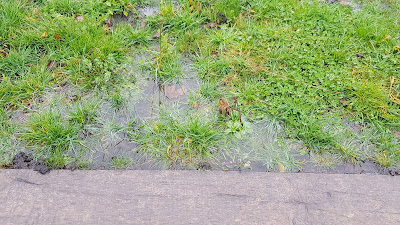Its very sad, but not uncommon to see the vast amounts of flooding across rural and urban areas and the devastation this brings. Locally, there are loads of blocked drains and copious damage to roads.
Our own mini-SuDS project funded by Keep Wales Tiday was finisheed a couple of years ago and is reported in the previous blog entry. What we were seeing was the car park itself was getting flooded as the drains were blocked by silt.
The silt was coming from the grassy hill adjacent to the car park. As people were walking up or down the bank, desirelines would muddying up and vegetation being trampled. The rain then washed down these desirelines taking silt downhill, emptying into the car park and blocking the drains. Our solution to this was very simple in that we roped off some of the desirelines, planted some shrubby vegetation on here, dug a few little trenches which fed into small shallow silt traps and most importantly at the botttom of the hill, we built a retaining wall of oak sleepers, backfilled these with soil and overlaid these with our favourite native wildflower turf
(htps://twitter.com/HenllysLNR/status/1314828591805411328). We've recorded on our Facebook page and Twitter how well these have worked (https://twitter.com/HenllysLNR/status/1397112031971577856 https://twitter.com/HenllysLNR/status/1335321551051366400).
Trench and mini-silt trap
Silt settles into wildflower turf and clean water drains through the gaps in the oak sleepers as well as over the top of the turf.



















